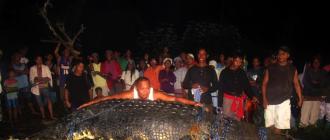The largest crocodile species. The largest crocodiles in the world Fat crocodile
If an unusual incident happened to you, you saw a strange creature or an incomprehensible phenomenon, you had an unusual dream, you saw a UFO in the sky or became a victim of an alien abduction, you can send us your story and it will be published on our website ===> .
The largest crocodile in the world, weighing more than a ton and 6.4 meters in length, was caught in the Philippines.

According to local authorities, the predator attacked livestock and people. Locals believe a huge crocodile may have eaten a farmer who went missing in July this year and several buffaloes south of Bunawan. The Ministry of the Environment does not exclude that the predator may also be involved in the death of a 12-year-old girl in 2009.
"According to previous records of wildlife captures, the largest crocodile was a reptile 5.48 meters in length. It is one of the largest animals that I have caught in the past 20 years," - told reporters Josephine de Leon from the Ministry of the Environment and wildlife. According to experts, a carnivorous reptile can be over 50 years old.

“The locals have calmed down. Of course, we cannot be sure that we have caught a man-eating crocodile, as there are other predators in the region,” said Josephine de Leon.
The authorities decided not to kill the animal, but to place it in a zoo under construction in Bunwan to attract tourists.
The captured predator is a member of the family of combed crocodiles, which are considered the largest crocodiles on Earth. According to scientists, representatives of this species can reach up to 7 meters in length and live for over 100 years.
Since the Mesozoic era, these reptiles have chosen the aquatic environment. Some of them reached colossal proportions. They were even able to hunt dinosaurs and large mammals. Are you curious who is the record holder among them?
So, the largest crocodiles in the history of our planet:
So far, we are highlighting seven positions, but we will gradually increase their number. In this case, the rating will be periodically updated.
Note that the competition among crocodiles is very tight. Moreover, there are no obvious advantages in representatives of any particular family. It is possible that the largest crocodile in the world has not yet been found. It is also worth noting that most of the participants are found in Africa and South America.

Graphical comparison of several giants with humans and the combed crocodile (the largest modern species is Crocodylus porosus).
As you can see, today the Mesozoic sarcosuchus, which lived side by side with dinosaurs, is leading by a small margin. Apart from a long skull, the largest crocodile had impressive protection (more on its profile).

Comparison of Sarcosuchus to the largest land mammal of our day, the African elephant.
Despite the fact that all giants were predators, the average diet could be quite different. Some, such as influenza, were real masters in catching fish and other aquatic inhabitants. Others, such as Purusaurus and Deinosuchus, often hunted large land animals. Still others, for example sarcosuchus, occupied an intermediate position.

Deinosuchus, Puruszaurus and Sarcosuchus, placed by the Spanish artist Alvaro Rosalen in one body of water.
Article author: ArgusEyeLiterature
Recommended scientific works (- journals with limited access):- Haley D. O'Brien; Leigha M. Lynch; Kent A. Vliet; John Brueggen; Gregory M. Erickson; Paul M. Gignac (2019).
The giant lizards that thrill people and animals with their size and unsurpassed hunting abilities are crocodiles. The largest representative of this family is the so-called combed crocodile. Why did he get such a name, and what is the way of life of these predators? Read more in our article.
The combed crocodile (Crocodylus porosus) is also called the sea. He is the most prominent member of the family. These animals have earned a reputation as the largest and most violent reptiles among their crocodile tribesmen.
The combed crocodiles and their closest relatives alligators, caimans and gharials have an impressive ancestry - their ancestors were the dinosaurs themselves.
The ancient lizards, however, surpassed modern crocodiles in size, reaching a length of 13 m. It is by the example of crocodiles that mankind can imagine the appearance of ancient extinct animals. Over the past hundreds of thousands of years, crocodiles have changed little and still resemble their ancient relatives in appearance and habits.
Anatomy and physiology
The combed crocodile is so named for a reason. Its head is crowned with two rows of ridges located in the middle of the crocodile's muzzle and going from the eyes to the nostrils. Young individuals do not have such adornments - only adult animals wear combs.

The saltwater crocodile is distinguished from its contemporaries by the presence of small scales on the belly. Such "chain mail" does not undergo the process of ossification, that is, it does not turn into osteoderm.
- At birth, crocodiles weigh no more than 70 g, and their body length is 30 cm.
- Males are considered capable of breeding, reaching a length of 3 m, females - 2 m.
- Some adult crocodiles can grow up to 6 m and weigh about 1000 kg.
- On average, the length of a crocodile is 4 - 5 m, weight - 450 - 800 kg. Females are smaller, reaching 2 - 3.5 m and weighing 450 kg.
Yellowish scales evenly cover the entire body of the lizard, and dark specks form on its tail and body. In sexually mature individuals, the skin becomes darker, eventually acquiring a greenish-gray tint with brown blotches. The belly of the crocodile is yellow-gray, the tail is painted with dark stripes.
For your information. Crocodiles even in skull structure resemble their dinosaur ancestors. The organs of hearing and touch of this lizard are located in the immediate vicinity of the crown. This feature helps crocodiles to stay under water for a long time, exposing their nostrils. Observing in this way what is happening on the shore, the crocodile senses prey, which is many meters away from him.
Lifestyle and habitat
Saltwater crocodiles can live in both fresh and salt water. At the same time, the reptile can be found on the ocean coast, in lakes, swamps, rivers. Able to swim far into the sea, the lizard easily drifts from coast to coast. But most often, cresty creatures live in deep water.

Special glands, which are "equipped" with a crocodile, help him to remove salt from the body. Thanks to this feature, the animal can live in salt water, but he cannot drink it. He gets the missing moisture from the food he gets.
These predators are considered lonely - each of them has its own "room" within the reservoir. On land, crocodiles move slowly, at a speed of 3 - 5 km / h, but in water they can accelerate to 30 km / h.
During the day, toothy reptiles bask in the water, preferring to hunt early in the morning or at dusk. Crocodiles feel most comfortable in a tropical climate, and therefore are able to migrate when cold weather sets in.
Saltwater crocodiles live in the Indian and Pacific Oceans. They can also be found in the coastal waters of Sri Lanka, New Guinea, India, Vietnam, Indonesia, East and Southeast Asia. But the largest concentrations of these predators are found in the north of Australia. Able to swim quickly, these crocodiles reach the coast of the Philippines or Japan.
Reptile behavior and nutrition
This type of reptile feeds on mammals, fish and birds. Individuals living in the seas can easily cope with even a great white shark. Adult predators kill buffalo, antelope and other large horned animals. Also, their menu may include wild boars, leopards, monkeys, crabs, snakes. Cubs eat fish, insects, shellfish. During periods of hunger, this animal is able to commit an act of cannibalism, eating its own kind.

These predators have interesting feeding habits. Crocodiles do not eat large prey right there. Pulling victims to a depth, they place them under snags and stones to prevent surfacing. When the meat begins to decompose, the lizard starts eating. It is not uncommon, however, when the prey hidden in this way goes to other carnivores.
When hunting, the crocodile disguises itself in the water, waiting for the victim to approach. Suddenly attacking prey, the predator knocks it down with a blow of its tail or captures it with its powerful jaws. The reptile drags the defeated animal into deep water until the victim finally drowns.
Bite force, attack on humans
The terrible crocodile's mouth is equipped with tapered teeth 5 cm long each. There are cavities inside them, in which new chewing units are subsequently formed when the old ones wear out. The total number of teeth can reach hundreds.

The combed crocodile is the most dangerous representative of its family for humans. About 2,000 people become its victims annually. The largest number of attacks is recorded on the coast of Australia.
It is interesting. In 1945, combed crocodiles staged a real bloody massacre on Ramri Island. 1000 Japanese soldiers, trying to wade the local swamps, were attacked by toothy creatures. Only a few dozen soldiers managed to escape.
The sea lizard is the record holder for the power of jaws among all animals living on the planet. So, the force of a crocodile bite is 16480 Newtons, or 251 atmospheres. For comparison, the bite force of a jaguar is 136 atmospheres, a hippo - 124.
Large individuals often attack pleasure boats and bite through them without difficulty.
Reproduction and life expectancy
With the onset of the mating season, crocodiles become extremely inventive in matters of flirting. To lure females, males make various movements, slap their muzzles on the water, and make characteristic sounds reminiscent of croaking. In a short period after mating, the female lays 40-60 eggs in a previously dug clutch.

The crocodile is an example of true maternal dedication. Indeed, after burying eggs in the sand, she is continuously near them for almost 3 months, while remaining hungry. The female carries the hatched cubs with extreme caution in her mouth to the water.
It is interesting. Moving to the water, the female crocodile can also transfer newborn turtles with her children. Their parents often lay eggs near crocodiles, considering the formidable, toothy mother to be an excellent guardian.
Crocodiles are long-lived predators living in the wild for about 60 - 80 years.
Red Book, interesting facts
Salted crocodiles are the inhabitants of the Red Book, because even at the end of the last century, their population was balancing on the verge of complete extinction. And all because of the value of crocodile skin, which made these predators a target of poachers and hunters. Now the law restricts hunting for large lizards.
![]()
Many years of experience in observing crocodiles by naturalists allows us to highlight several interesting facts about them:
- In literal translation "crocodile" means "pebble worm". There are several explanations for this name. The most common is the version about the similarity of scales on a crocodile body with small pebbles.
- Crocodiles grow and grow in size throughout their lives. This is due to the continuous growth of cartilage tissue.
- Being in water, reptiles are not able to close their mouths. At the same time, water does not enter the predator's body due to the presence of a secondary bony palate. The so-called palatine curtain acts as a valve, and the crocodile is able to breathe through the nostrils exposed to the surface of the water.
- The stomach of the crocodile is supplied with gastroliths - the so-called "stomach stones". They help him grind tough food and shift the center of gravity with the crocodile while swimming.
- The crocodile is one of the few animals that have practically not changed in appearance since prehistoric times. This is explained by the way of life of reptiles - both then and now they lived and live in water. It was such a habitat that saved the life of the lizards, since the waters of the World Ocean almost always kept approximately the same temperature.
- The largest combed crocodile in the world was caught in the Philippines in 2011. The body length of the predator was 6.17 m, weight - 1075 kg.
Formidable crested crocodiles are beautiful and dangerous creatures. Direct descendants of dinosaurs, these dinosaurs are distinguished by their cunning and fearlessness. Both animals and people can become victims of a reptile - powerful jaws allow the crocodile to choose an object for hunting at its own discretion.
It is not difficult to distinguish a crocodile from an alligator - crocodiles have a more elongated jaw and you can clearly see the upper front tooth.
This predator, dangerous even for humans, can reach impressive sizes. Today, the largest crocodile in the world is the ridged (ridged) crocodile. It is named so because of the two characteristic ridges on the reptile's nose, going from the eyes to the middle of the upper jaw. Such crocodiles inhabit a fairly large territory - they can be found off the eastern coasts of Africa and India and the Far East, in most of the states of South Asia and off the coast of Japan. Their habitat also stretches from South Asia to Northern Australia.
There have been several individuals in the world that are rightfully considered champions because of their size in recent decades.
Cannibal Gustav from Burundi
Of these, the largest crocodile named Gustav was shot in 1987. at the request of local residents in the Republic of Burundi, where he terrified the local population. There were rumors about the killing of about 300 people by this reptile, and local residents said that the crocodile hunts people, but does not eat them.
Crocodile Gustav
This crocodile reached 6.1 meters in length and weighed over a ton. Scientists suggest that other, larger crocodiles can be found in the area of Gustav's habitation, but there is only accurate information about the existence of Gustav, who was considered the largest.
Centenarian Cassius Clay
Today, Cassius Clay lives in Australia - the oldest crocodile, which is recognized as the largest crocodile living in salt water. In 2013, the Australians celebrated the 110th anniversary of the animal.

Crocodile Cassius Clay
The name of the reptile was given in honor of the famous boxer (Cassius Clay is his real name). Cassius length - 5.48 m, weight - 1000 kg. He appeared in 2011 in the Guinness Book of Records as the largest crocodile.
Filipino Lolong
All crestal crocodiles can live in both fresh and salt water, often live in river mouths, where they hunt. In 2011, in the town of Buanavan in the Philippines, an even larger crocodile than Gustav, named Lolong, was caught.

Crocodile Lolong
He was placed in a specially built water ecopark for him, where he lived until 2013. There are two reasons for the death of the reptile - a nylon cord swallowed by a crocodile and unusually cold weather for this climate. Officially, the reason has not yet been named. Lolong was 6.4 meters long and weighed over a ton. For a short time in 2012, it was entered in the Guinness Book of Records, but after the death of a reptile, the largest crocodile in the world is still Cassius Clay.
The largest ever
Of all the crocodiles that lived on our planet, the largest was sarcosuchus, which lived on Earth during the Cretaceous period. It reached a length of 12 meters and weighed about 8 tons. Scientists made such a conclusion from the found animal remains. In the middle of the 20th century in the Sahara, the French paleontologist Albert-Felix de Lapparent found teeth and several armor shields of such a crocodile, later skeletons were also found.

Crocodile skeleton sarcosuchus
Although crocodiles can kill a person, today people more often hunt and kill these reptiles. After all, crocodile skin is a very valuable material, for the sake of which crocodiles are massively exterminated, and their number in the world has greatly decreased in recent years. Play a role in the reduction of their number and such factors as the development of human habitats of these animals and the extermination of fear, since crocodiles often hunt people.
In some countries (Australia, India, Myanmar), reptiles are taken under protection. There are programs to restore their numbers, young crocodiles are raised on egg farms, and hunting is prohibited. The strongest reptile protection measures are being taken in Australia, and their numbers there have increased in recent years. And in countries like Sri Lanka and Thailand, crocodiles are likely to have completely disappeared. In Vietnam, their number does not exceed 100 individuals.
And in continuation of the topic of the largest animals, we suggest that you familiarize yourself with.
We, living in relatively cool countries, do not understand the irrational sacred horror that crocodiles caused among the same ancient Egyptians. They were worshiped and hated, revered as messengers of the gods and destroyed, as best they could, mummified and eaten. But people have never been indifferent to them.
This is just not surprising: it is difficult to ignore 4-5 meters of muscles armed with sharp teeth. More surprisingly, something else is more likely - these creatures have inhabited the Earth for more than 250 million years, having not significantly changed during this time. This can only say about one thing: a crocodile is an ideal creation of nature, which simply does not need to be further improved.
But all the same, a legitimate and completely logical question arises: where does the largest crocodile live? What species does it belong to? And most importantly: how big is it? We will try to answer.
Ridged or Nile?
For a start, it would be nice to figure out who gave the world the champion what species: the combed crocodile or the Nile? The answer to this question is not so easy. Both species are impressive, but almost the same size: males up to 5-5.5 meters, females are shorter and lighter. Some individuals can grow up to 6-7 meters, but this is rather an exception, champions and winners. With the weight it is a little easier: the ridged one seems to be more massive, although again not much: the average weight is 500-600, the peak weight is 1000 and more. But the Nile is practically the same.
But they have completely different habitats. The Nile crocodile, as it should, occupied the banks of the Nile and the surrounding area, populating Africa. The cresty one settled on the shores of Australia and Asia, simultaneously occupying all the islands located between it. And this is all thanks to the fact that it tolerates salt water well and can swim impressive distances. Some crocodiles were found even in Japan, to the great surprise of the local population.
With the quantity, too, everything is not as simple as we would like it to be. Nile is not yet listed in the Red Book, but individual populations have already been destroyed. Saltwater feels good in Australia under the strict supervision of wildlife guards, but on many islands, for example, Seychelles, to the delight of tourists, it is completely exterminated.
Therefore, although officially the leader in the team competition belongs to the combed one, the decision can be challenged. But in the individual competition, such problems should not arise.
Cassius Clay
This is not only the real name of Mohamed Ali, but also the longest crocodile living today. This favorite of tourists recently celebrated its 110th anniversary, but is not going to leave us yet. On his birthday, he cheerfully destroyed a 20-pound birthday cake made from raw meat.
And this is quite logical, because your 5.5 meters and a ton of weight need to be well fed. They say that it used to be even longer, until it lost a piece of its tail in a fight. But even the remaining carcass was enough to get into the Guinness Book of Records and even take a whole spread there instead of the usual one page.
The birthday boy did not share with anyone
He has lived in captivity since 1984, when he was caught and transferred to a crocodile park in Australia. Here he found a calm life, hearty delicious food and worldwide fame. What more could a crocodile wish for in old age?
But Cassius Clay once nearly lost his laurels. In the Philippines, an even larger specimen was caught and taken to the local zoo - 6 meters 17 centimeters from the tip of the tail to the front teeth.

Caught by the whole world
Lolong is a bad boy, suspected of being addicted to human meat and the death of several people. Therefore, the inhabitants of the town of Bunawan jointly caught the predator. Someone far-sighted advised not to kill him, but to hand him over to the local zoo in order to make him a curiosity that attracts tourists. The cunning plan worked, and every day hundreds of people came to see this monster with their own eyes - a solid addition to the local budget.
Unfortunately, life in captivity was not to his taste. In protest (or foolishly), he ate a nylon cord and a few days later floated belly up. The veterinarian witnessed death, and the title returned to Clay.
Uncrowned champions
But the confrontation between these heavyweights is not the limit. And, most likely, the largest crocodiles still swim somewhere in the Nile or the waters of Australia. Perhaps someday they will at least be able to be seen.
Like, for example, the Nile crocodile Gustav, who has not yet been caught by any expedition. Although many tried, what his special examples say - a few scars from bullets on his skin. But he paid for them. It is believed that more than 300 human deaths are on his conscience.
The last time they managed to put him in a cage, an enraged Gusta broke it and hid in the waters of the Nile. The result of the expedition was a film from National Geographic and the exact length of his body is 6 meters 10 centimeters. At the moment, this is an absolute record. Although it has not yet been possible to give the award to the winner. But the film "Primal Evil" was made about him.
Real primal evil
It's good that their older relatives - intermediate variants between dinosaurs and crocodiles - are already extinct. Compared to them, Gustav, Lolong, and Cassius would be dwarfs, undersized, cute and harmless lizards. See for yourself:
- Sarcosuchus. Length - up to 12 meters. Weight - up to 8 tons. Lived in modern Africa 110 million years ago.
- Deinosuchus. Length - up to 15 meters. Weight - 8-10 tons. He lived 80-73 million years ago.
- Pursusaurus. Length - up to 15 meters. Weight - up to 7 tons. Extinct about 8 million years ago.
Of course, any scientist would like to see and describe such crocodiles. But the consequences of such a meeting might not have pleased him at all.





